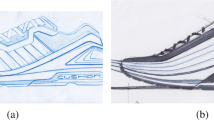Abstract
Vector graphics plays an important role in computer animation and imaging technologies. However present techniques and tools cannot fully replace traditional pencil and paper. Additionally, vector representation of an image is not always available. There is not yet a good solution for vectorizing a picture drawn on a paper. This work attempts to solve the problem of vectorizing grayscale line drawings. The solution proposed uses Disk B-Spline curves to represent strokes of an image in vector form. The algorithm builds a vector representation from a grayscale raster image, which can be a scanned picture for instance. The proposed method uses a Gaussian sliding window to calculate skeleton and perceptive width of a stroke. As a result of vectorization, the given image is represented by a set of Disk B-Spline curves.
Similar content being viewed by others
Explore related subjects
Discover the latest articles, news and stories from top researchers in related subjects.References
Siu Chi Hsu, Irene H H Lee. Drawing and animation using skeletal strokes. In Proc. the 21st Annual Conference on Computer Graphics and Interactive Techniques, ACM Press, Orlando, Florida, USA, 1994, pp.109–118. http://doi.acm.org/10.1145/192161.192186.
Hsu S C, Lee I H H, Wiseman N E. Skeletal strokes. In Proc. the 6th Annual ACM Symposium on User Interface Software and Technology, ACM Press, Atlanta, Georgia, USA, 1993, pp.197–206. location = Atlanta, Georgia, United States http://doi.acm.org/10.1145/168642.168662.
Sebastiano Battiato, Giovanni Gallo, Giuseppe Messina. SVG rendering of real images using data dependent triangulation. In SCCG′04: Proc. the 20th Spring Conference on Computer Graphics, ACM Press, New York, USA, 2004, pp.185–192. isbn = 1-58113-967-5, location = Budmerice, Slovakia, http://doi.acm.org/10.1145/1037210.1037238.
Chiang J Y. A new approach for binary line image vectorization. In IEEE Int. Conf. Systems, Man and Cybernetics “Intelligent Systems for the 21st Century”, Vancouver, BC, Canada, 1995, Vol.2, pp.1489–1494.
Ju Jia Zou, Hong Yan. Line image vectorization based on shape partitioning and merging. In Proc. 15th International Conference on Pattern Recognition, 2000, 3: 994–997.
Xiao X, Soon H, Wu Z, Xie X. Interactive Free-Hand Drawing and In-Between Generation with Disk B-Spline Curves. In Conf. Multimedia Arts Asia Pacific, Singapore, ISBN: 981-05-2187-1, 2004.
Vladimir Pervouchine, Graham Leedham, Konstantin Melikhov. Handwritten character skeletonisation for forensic document analysis. In The 20th Annual ACM Symposium on Applied Computing, Santa Fe, New Mexico, 2005.
Afonso Ferreira, Stéphane Ubéda. Computing the medial axis transform in parallel with eight scan operations. IEEE Trans. Pattern Anal. Mach. Intell., 1999, 21(3): 277–282. http://dx.doi.org/10.1109/34.754629.
Balázs Kégl, Adam Krzyźak. Piecewise linear skeletonization using principal curves. IEEE Trans. Pattern Anal. Mach. Intell., IEEE Computer Society, 2002, 24(1): 59–74. http://dx.doi.org/10.1109/34.982884.
Louisa Lam, Seong-Whan Lee, Chiang Y Suen. Thinning methodologies—A comprehensive survey. IEEE Trans. Pattern Analysis and Machine Intelligence, 1992, 14(9):869–884.
Ju Jia Zou, Hung-Hsin Chang, Hong Yan. A new skeletonization algorithm based on constrained Delaunay triangulation. In International Symposium on Signal Processing and Its Applications, Vol.2, 1999, pp.927–930.
Tanaka N, Kamimura T, Tsukumo J. Development of a map vectorization method involving a shape reforming process. In Proc. the Second International Conference on Document Analysis and Recognition, 1993, pp.680–683.
Fred Attneave. Some information aspects of visual perception. Psychol., 1954, 61(3): 183–193.
Fischler M A, Wolf H C. Locating perceptually salient points on planar curves. IEEE Trans. Pattern Anal. Mach. Intell., IEEE Computer Society, 1994, 16(2): 113–129.
Konstantin Melikhov, Feng Tian, Hock Soon Seah, Quan Chen, Jie Qiu. Frame skeleton based auto-inbetweening in computer assisted cel animation. In Proc. the 2004 International Conference on Cyberworlds (CW′04), IEEE Computer Society, 2004, pp.216–223,
Horst J A, Beichl I. Efficient piecewise linear approximation of space curves using chord and arc length. SME Applied Machine Vision, Cincinnati, Ohio, June 1996.
Author information
Authors and Affiliations
Corresponding author
Additional information
A preliminary version of this paper appeared in Proc. Pacific Graphics 2005, Macau.
Konstantin Melikhov received the B.Eng degree in 2001 and M.Eng degree in 2003 from Moscow Institute of Physics and Technology (State University), Russia. Currently he is a Ph.D. candidate at Nanyang Technological University, School of Computer Engineering. His research areas cover computer assisted Cel animation and image processing.
Feng Tian is an assistant professor with the School of Computer Engineering (SCE), Nanyang Technological University (NTU), Singapore. He was a research fellow with Center for Graphics & Imaging Technology (CGIT), in NTU. His main research interests lie in the computer graphics and animation, computer vision and 3D profilometry, etc. He currently focuses on the research and development of Computer Assisted Cel Animation.
Jie Qiu is a Ph.D. candidate at School of Computer Engineering, Nanyang Technological University. His research areas cover computer assisted animation.
Quan Chen is a Ph.D. candidate at School of Computer Engineering, Nanyang Technological University research areas cover computer assisted animation.
Hock Soon Seah is dean and an associate professor of School of Computer Engineering, Nanyang Technological University, Singapore. His research areas cover computer vision research in tracking, extraction of camera trajectory, and 3D reconstruction from image sequences for augmented reality and automating 2D/3D computer graphics for the film/video industry.
Rights and permissions
About this article
Cite this article
Melikhov, K., Tian, F., Qiu, J. et al. DBSC-Based Grayscale Line Image Vectorization. J Comput Sci Technol 21, 244–248 (2006). https://doi.org/10.1007/s11390-006-0244-0
Revised:
Issue Date:
DOI: https://doi.org/10.1007/s11390-006-0244-0





